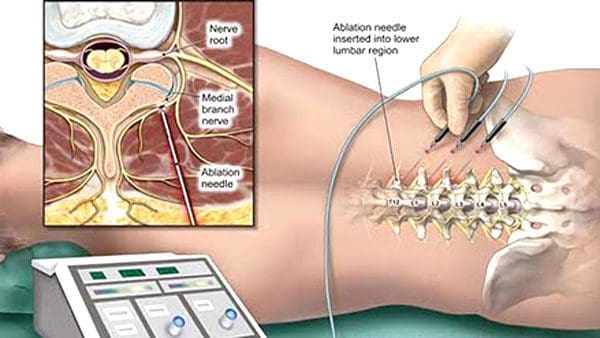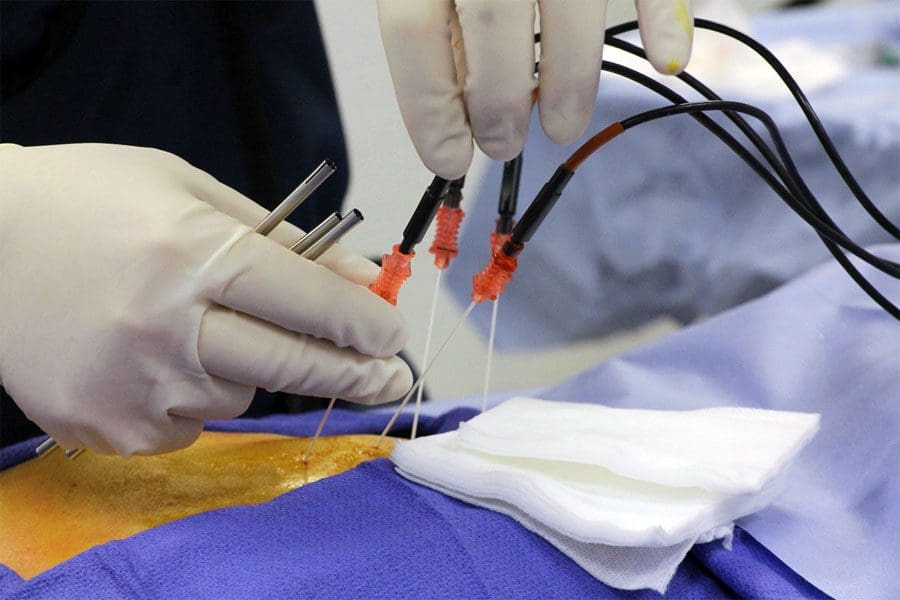Radiofrequency ablation, also known as RFA is a minimally invasive procedure performed in an outpatient clinic to treat neck, back, facet joints, and sacroiliac joint pain. It involves the use of radio waves pulsing at a high frequency that temporarily disable the nerves from transmitting pain signals to the brain. Relief can last three to six months. Radiofrequency ablation treatment could be an option to manage chronic back and neck pain. There are other names, but the radio frequency concept is the same. They are:
- Pulsed radiofrequency ablation
- RF ablation
- Radiofrequency lesioning
- Radiofrequency neurotomy
- Radiofrequency rhizotomy

Chronic neck, back, and hip pain take a significant toll on the body. Finding the right treatment can make all the difference. However, it does not work for everyone. For those that might have tried other non-surgical treatments to manage the pain, including physical therapy and steroid injections, that did not bring relief then radiofrequency ablation could be another treatment option.
Table of Contents
Radiofrequency Ablation Benefits
- Pain relief compared to steroid injections lasts longer
- Relief exceeds that of injections
- It is a non-surgical procedure
- Complication risks are low
- Opioid or other analgesic medication is reduced
- Quick recovery
- Improved quality of life
- Relief can last six months to a year, and longer

Pain Reduction
Before undergoing radiofrequency ablation, a doctor must pinpoint the nerves causing the neck, back, or sacroiliac joint pain. They will perform a nerve block injection to determine if there is temporary relief from the pain. If there is temporary relief it means that the origin of the pain was found. This could qualify to become a candidate for radiofrequency ablation.
- A Medial branch block is performed to diagnose the facet joint/s that are causing the pain.
- A sacroiliac joint block is performed to determine if and which sacroiliac joint is causing the pain.
Preparation
The doctor will give instructions on how to prepare for the procedure. Instructions can vary from those listed, as every patient’s case is unique.
- Do not eat 6 hours prior to your procedure
- Wear loose, comfortable clothing
- Easy to put on shoes
- Have a designated driver for after the procedure
- Make sure the doctor knows about all medications, vitamins, supplements, and herbs being taken
- Follow the doctor’s instructions when taking prescribed and over-the-counter medications. This includes vitamins, supplements, and herbs
- Bring all medications on the day of the procedure to be taken with minimal interruption
Radiofrequency ablation usually takes an hour or longer depending on the extent of the treatment. One example could be the number of facet joints being treated.
The Procedure
The patient will be positioned face down on the treatment table. Pillows are offered and positioned for optimal comfort. The area where the treatment will be administered is sterilized. The areas of the body not undergoing the treatment are covered with a sterile covering. Sedation could be utilized but not heavy sedation. More than likely it will be what is known as twilight sedation.
A local anesthetic is injected into and around the area/s being treated. Because radiofrequency ablation involves electricity a grounding pad is attached to the calf of one of the legs. The treatment table is adjusted for the precise placement of the needles and electrodes. The doctor will use fluoroscopy or a real-time x-ray as a guide.

Once the needle/s and electrode/s placement is confirmed, a low electrical current is sent through the electrodes. This creates waves of pulsating energy that stimulate and change the nerve/s sensory tissue so it does not send pain signals. Some individuals report a warm or mild pulsing sensation. When finished, the electrodes and needles are removed. The treated area is cleaned up, sterilized and bandages are applied.
After the Procedure
After the procedure, the patient is sent home with a set of recovery instructions. An example could be:
- Keep the bandages in place
- Don’t take a bath or shower
- A shower can be taken the following day and the bandages removed
- Do not perform any strenuous activity for up to two days
When the anesthetic wears off, the individual will have soreness and some mild pain around the treatment area. As long as everything is fine individuals can return to work and normal routine within three days. Full recovery can take up to two weeks for the treated/ablated nerves to stop sending pain signals. Although the nerves no longer conduct pain, it is temporary and not a permanent fix. This is because the nerves grow back. If the cycle starts over, talk with the doctor about another session.
LLT Laser Therapy for Peripheral Neuropathy
Dr. Alex Jimenez’s Blog Post Disclaimer
The scope of our information is limited to chiropractic, musculoskeletal, physical medicines, wellness, and sensitive health issues and/or functional medicine articles, topics, and discussions. We use functional health & wellness protocols to treat and support care for injuries or disorders of the musculoskeletal system. Our posts, topics, subjects, and insights cover clinical matters, issues, and topics that relate and support directly or indirectly our clinical scope of practice.*
Our office has made a reasonable attempt to provide supportive citations and has identified the relevant research study or studies supporting our posts. We also make copies of supporting research studies available to the board and or the public upon request. We understand that we cover matters that require an additional explanation as to how it may assist in a particular care plan or treatment protocol; therefore, to further discuss the subject matter above, please feel free to ask Dr. Alex Jimenez or contact us at 915-850-0900. The provider(s) Licensed in Texas& New Mexico*
Post Disclaimer
Professional Scope of Practice *
The information on this blog site is not intended to replace a one-on-one relationship with a qualified healthcare professional or licensed physician and is not medical advice. We encourage you to make healthcare decisions based on your research and partnership with a qualified healthcare professional.
Blog Information & Scope Discussions
Welcome to El Paso's Premier Wellness and Injury Care Clinic & Wellness Blog, where Dr. Alex Jimenez, DC, FNP-C, a board-certified Family Practice Nurse Practitioner (FNP-BC) and Chiropractor (DC), presents insights on how our team is dedicated to holistic healing and personalized care. Our practice aligns with evidence-based treatment protocols inspired by integrative medicine principles, similar to those found on this site and our family practice-based chiromed.com site, focusing on restoring health naturally for patients of all ages.
Our areas of chiropractic practice include Wellness & Nutrition, Chronic Pain, Personal Injury, Auto Accident Care, Work Injuries, Back Injury, Low Back Pain, Neck Pain, Migraine Headaches, Sports Injuries, Severe Sciatica, Scoliosis, Complex Herniated Discs, Fibromyalgia, Chronic Pain, Complex Injuries, Stress Management, Functional Medicine Treatments, and in-scope care protocols.
Our information scope is limited to chiropractic, musculoskeletal, physical medicine, wellness, contributing etiological viscerosomatic disturbances within clinical presentations, associated somato-visceral reflex clinical dynamics, subluxation complexes, sensitive health issues, and functional medicine articles, topics, and discussions.
We provide and present clinical collaboration with specialists from various disciplines. Each specialist is governed by their professional scope of practice and their jurisdiction of licensure. We use functional health & wellness protocols to treat and support care for the injuries or disorders of the musculoskeletal system.
Our videos, posts, topics, subjects, and insights cover clinical matters and issues that relate to and directly or indirectly support our clinical scope of practice.*
Our office has made a reasonable effort to provide supportive citations and has identified relevant research studies that support our posts. We provide copies of supporting research studies available to regulatory boards and the public upon request.
We understand that we cover matters that require an additional explanation of how they may assist in a particular care plan or treatment protocol; therefore, to discuss the subject matter above further, please feel free to ask Dr. Alex Jimenez, DC, APRN, FNP-BC, or contact us at 915-850-0900.
We are here to help you and your family.
Blessings
Dr. Alex Jimenez DC, MSACP, APRN, FNP-BC*, CCST, IFMCP, CFMP, ATN
email: coach@elpasofunctionalmedicine.com
Licensed as a Doctor of Chiropractic (DC) in Texas & New Mexico*
Texas DC License # TX5807
New Mexico DC License # NM-DC2182
Licensed as a Registered Nurse (RN*) in Texas & Multistate
Texas RN License # 1191402
ANCC FNP-BC: Board Certified Nurse Practitioner*
Compact Status: Multi-State License: Authorized to Practice in 40 States*
Graduate with Honors: ICHS: MSN-FNP (Family Nurse Practitioner Program)
Degree Granted. Master's in Family Practice MSN Diploma (Cum Laude)
Dr. Alex Jimenez, DC, APRN, FNP-BC*, CFMP, IFMCP, ATN, CCST
My Digital Business Card


